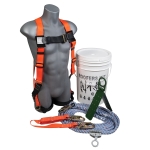Fall Arrest Protection
Fall arrest is the act of stopping a person that is already falling and therefore personal protective equipment has been developed to help save lives.
Fall protection equipment is provided in various components including personal body harnesses, lanyards and lifelines.
A package for protecting workers from falls greater then 6 feet would consist of the following components. Individually none of these devices will provide protection from a fall however when used together they form a Personal Fall Arrest System, which becomes vitally important to safety at work.
- Anchorage – a fixed structure or structural adaptation, often including an anchorage connector, to which the other components of the fall protection equipment are rigged.
- Body Wear – a full body harness worn by the worker.
- Connector – a subsystem component connecting the harness to the anchorage – such as a 6 Foot Lanyard.
There are different components and combinations that can be used and it really comes down to the specific job task and how the workers are moving around the structure in order to complete their work.
The safety factor when it comes to fall arrest has a lot to do with how the energy of the person’s weight and distance is absorbed in a fall. The load on the worker can be different in any situation depending on such factors as the user’s weight, height of fall, geometry and the type of line/rope. The energy that is created by these factors is absorbed by the designated PPE.
Industries that utilize fall arrest systems tend to use the vertical lifeline in the form of a stranded rope that is connected to an anchor above and then attached to the worker through a “shock absorbing” (energy absorbing) lanyard. The system comes together and the anchor connection is referred to as an anchorage and along with the rope it is then called a “lifeline”.
The rope can be lifeline rope in itself which will stretch to lengthen the fall distance and absorbing the energy of the weight and distance. Another design is to have a static rope which does not stretch and thus limits the fall distance and the energy must be absorbed by another device such as a shock absorbing lanyard.
It is essential that the PPE be rated for the job task and all the factors are taken in to account such as weight, distance and number of workers attached to the system.
Terry Smeader
Latest posts by Terry Smeader (see all)
- Why You Should Buy the Bulwark IQ Series Flame Resistant FR Mobility Coverall - April 17, 2025
- The Complete Guide to Women’s Flame Resistant Clothing: Safety, Style, and Selection - April 8, 2025
- What Are FR Coveralls - April 7, 2025
Tags: equipment, Fall Arrest, PPE, Protection
